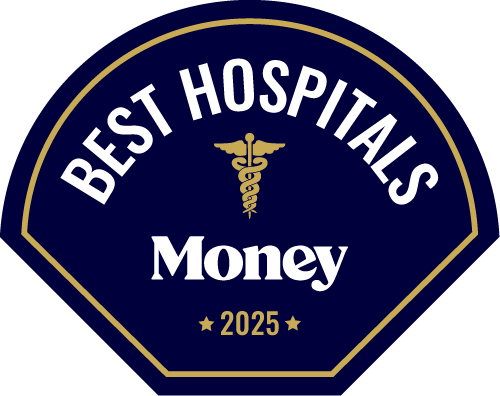Choosing the best hospital can be a complicated endeavor. There are over 6,000 such medical institutions across the United States, and patients often lack the time, energy and expertise to evaluate the best choice, even among the facilities close to where they live.
That’s why Money has again ranked the nation’s hospitals, building on our robust rankings of previous years to analyze over 30,000 data points on 1,000 top-performing facilities in 2025.
In addition, we’ve assembled separate lists of hospitals that stand out for their care in some common specialty areas, including pediatric care, cardiac care and cancer care.
Our process for pruning the list of all hospitals in the country to shortlists of the standouts involves analyses of data from over a dozen different sources. Here’s the sequence of steps we take:
- Consider only high-quality hospitals
- Refine the list based on how experienced the hospitals’ doctors are
- Vet the hospitals before we finalize the list
- Rate the transparency of hospitals’ pricing
And, to supplement the steps used for all our hospital rankings, here are the methods that are unique to our specialized lists. (The 2024 specialized lists will be updated throughout 2025, including the addition of several new rankings this year.)
- Best hospitals for neurology methodology
- Best hospitals for cardiac care methodology
- Best hospitals for rehabilitation methodology
- Best hospitals for orthopedic surgery methodology
- Best hospitals for geriatric care methodology
- Best hospitals for pediatric care methodology
- Best hospitals by region methodology
- Best hospitals for maternity care methodology
- Best hospitals for cancer care methodology
- Best hospitals for bariatric surgery methodology
Overall methodology
The following methods outline how we crafted our overall list of the 75 best hospitals in 2025. As noted above, for our specialty hospital rankings, we replicated several of these steps but also introduced new data, factors and weighting unique to each list. (See below for more details.)
Consider only high-quality hospitals
Our first step to whittling down 6,000-plus hospitals across the country is to consider only facilities that received a four- or five-star rating for quality from the federal Centers for Medicare & Medicaid Services (CMS). According to CMS, fewer than 1,300 hospitals have a 4-star rating or higher.
The CMS rating (included on the list of hospitals as “federal rating”) is based on five key factors that are weighted as follows:
- Mortality (22%): measures the death rates related to cardiovascular issues, strokes, pneumonia and treatable complications after surgery
- Safety (22%): tracks the rate of infections associated with certain surgeries, IVs and catheters and rates of complications after specific procedures
- Readmission (22%): considers how often some patients are readmitted to the hospital, along with how long they stayed and whether there were unplanned visits for outpatient treatment
- Patient experience (22%): gauges whether patients had a positive experience based on their self-reported ratings of how well their doctors and nurses communicated with them; other factors include whether their bathroom was clean and their room was quiet at night
- Timely and effective care (12%): estimates how quickly patients received care for chest pain or strokes; how long they stayed during an ER visit; percent of health care staff who are vaccinated for flu and COVID-19 and other time-sensitive metrics.
The CMS patient experience score, denoted as “patient rating” on the list, is separately displayed so that the opinions of previous patients can easily be considered. Collectively, the CMS scores were weighted at 35% of the hospitals’ overall score.
In addition to these federal metrics, Money incorporated several new gauges of the quality of care a hospital provides.
We rewarded hospitals that have received accolades from The Joint Commission, the American College of Surgeons or the facilities’ respective state health agency for implementing equitable health care practices and meeting benchmarks for providing round-the-clock trauma care.
Additionally, we favored facilities that are academic medical centers and have participated in clinical trials as a way to recognize hospitals that are implementing cutting-edge treatments.
Research and accolade metrics represent 15% of the overall score.
Refine lists based on how experienced the hospitals’ doctors are
Money leveraged a novel way that Denniston Data, a provider of health care data, measures quality care: by identifying high-performing doctors and other providers based on their level of experience with certain procedures.
Each of the hospitals on our list has been assigned an overall letter grade of between A+ and B, the latter being the minimum grade we considered for inclusion, after culling out lower scoring facilities.
Several studies show that the more experienced a physician is with a certain procedure, the better the health outcome for the patient — and by a large margin. Denniston scores more than 1 million providers through its “Provider Ranking System” (PRS). The PRS measures each provider’s experience with a certain procedure or within a specific specialty by analyzing the frequency of treatment and billable costs as reported to CMS through the Healthcare Common Procedure Coding System (HCPCS).
The frequency of the procedure by the provider is then compared to other providers, with each practitioner being given a score of between 0% to 100% based on their experience — where 98%, for example, means only 2% of providers ranked higher.
This approach is more equitable than measures of hospital quality that focus heavily on negative events; these include mortality (death) rates, how often patients must be readmitted to the hospital and other bad health outcomes. Not that these factors aren’t crucial to track; indeed they are among those we use to make our first cut in the list of facilities, drawing from the federal CMS data.
But heavily weighting these statistics can unfairly penalize providers and hospitals that operate in areas where the patient population — due to social or racial inequities, as examples — may be more likely to have poor health outcomes regardless of the quality of care they receive. For example, a physician in a high-income suburban hospital may have fewer adverse events treating a largely healthy and wealthy population compared to another physician who is working at a free clinic in a low-income urban neighborhood.
Based on the provider scores, Denniston combines the data to score each hospital based on a weighted average of its practitioners’ scores, creating a hospital-level Composite Ranking Score (CRS).
The CRS is a percentile that gets translated into a letter grade. The letter grading system is based on this percentage range:
- A+ is a CRS score of 95% to 100%.
- A is 85% to 94.99%.
- A- is 80% to 84.99%.
- B+ is 75% to 79.99%.
- B is 65% to 74.99%.
- B- is CRS 60% to 64.99%.
- C+ is 55% to 59.99%.
- C is 45% to 54.99%.
- C- is 40% to 49.99%.
- D+ is 35% to 39.99%.
- D is 25% to 34.99%.
- D- is 20% to 24.99%.
- F is below 20%.
This letter grade is displayed as the "Physician Rating” on the ranking list and constitutes 50% of a hospital’s total score.
Vet each hospital before we finalize the list
To compile our final list of 75 hospitals, we individually vetted each of the highest-rated facilities — as determined by our analyses laid out above — to be sure that none had disqualifying red flags that weren't evident in the data.
Money excluded several hospitals for either scandals where patient care was compromised (such as upheld complaints of sexual assault, racial discrimination or unnecessary treatment) or that the hospital does not offer emergency care or other services commonly expected of a general hospital
In the case where a hospital was excluded, we vetted the next highest-ranking hospital based on its raw score until we reached a total of 75 facilities.
The result is a comprehensive list of quality hospitals staffed by quality physicians and health care providers, hand picked and vetted by Money’s editorial staff.
Rate the transparency of hospitals’ pricing
After consulting health care data experts at Denniston and the nonprofit RAND Health Care, Money analyzed the extent to which a hospital’s publicly listed prices (known as “chargemaster prices”) accurately align with the revenue the hospital receives from patients or Medicare. In effect, we wanted to know: How likely is it that the listed prices will match what you’re billed after you’re discharged?
We used two ratios to measure this. The first compared the hospital's chargemaster prices and its net patient revenue, whether paid by uninsured patients or insurance companies; the second ratio is between the gross billed amount and the total amount approved by Medicare. Weighted equally, these ratios were standardized on a 100-point scale and translated into a letter grade based on the same ranges as listed above for the CRS.
New to our 2025 rankings, we also factored in the estimated amount of charity care, or free care, a hospital provides, and deducted that total from the gross charges a hospital bills to patients. This allows us to better measure the true amount a patient (or insurer) owes.
The result: a Price Transparency measure. The lower a hospital’s grade on this measure, the wider the gap between its listed prices and what patients have actually paid; the higher the grade, the smaller the difference between the facility’s public prices and the actual bills it issues.
In almost all cases, patients pay less — and often far less — than the publicly listed prices. While this practice is technically discounting, the reality is that many hospitals publicly list exorbitant chargemaster prices that often get negotiated down by insurers, the federal government or the patients themselves. While this practice may help certain patients, it also obfuscates what hospital care truly costs and threatens to keep overall health care costs high.
The price transparency grade does not necessarily mean that a hospital that's graded B+ is cheaper than one with a C. Rather, it means its publicly listed prices are more accurate, and so will be more reliable as you financially prepare for your hospital stay.
Because we judged quality of care and patient experience to be the most important considerations by far in choosing a good hospital, we did not weight price transparency on our rankings. However, we think it is a consideration in choosing a facility – and, perhaps, in whether you negotiate any discrepancies between its listed price for care and the amount you are billed.
Additional methodology notes by hospital category
Below are details specific to our rankings for specialty care. Additional methods for new specialized lists will be added throughout 2025 as those rankings are published.
Best hospitals for neurology
In a new addition to our hospital sub-lists, Money released a ranking of the best hospitals for neurology in June 2025. Our analysis highlights experienced neurologists, neurosurgeons and other specialists working at safe, high-quality hospitals.
We used three core components to measure this: a neurological specialty category (weighted at 45%), a hospital-wide safety and quality category (25%), and federal CMS ratings (20%).
Read our full methodology for neurology for details.
Best hospitals for cardiac care
Money updated its ranking of the best hospitals for cardiac care in June 2025.
Much like the rigorous process outlined above, our updated analysis highlights experienced physicians — in this case, cardiologists and other specialists — working at safe, high-quality hospitals. We favored facilities with accreditations and accolades from the American College of Cardiology that safely performed an array of cardiac procedures.
We broke down the analysis into four key components: CMS ratings (25%), cardiac resources (25%), cardiac services (25%) and quality of cardiac services (25%).
Read our full cardiac care methodology for more details.
Best hospitals for rehabilitation
In May 2025, Money introduced a specialty list of the best hospitals for rehabilitation.
While our overall methods remain largely consistent with the process detailed above, this specialty ranking includes several analyses unique to rehabilitative care.
Our ranking prioritizes well-staffed hospitals and inpatient rehabilitation centers that provide multidisciplinary recovery care from experienced physicians and specialists.
Four core components of excellence in rehabilitation care were considered, and weighted as follows: Rehab specialization (40%), quality and patient ratings (30%), clinical trial participation (15%) and staffing (15%).
For an in-depth explanation, read our full methods page for rehabilitation.
Best hospitals for orthopedic surgery
To determine the best hospitals for orthopedic surgery, Money conducted a new analysis in May 2025.
While our methodological approach largely mirrors the rigorous process laid out above, this sub-ranking differs in a few key areas.
Our analysis highlights experienced physicians — in this case, orthopedic surgeons and other specialists — working at safe, high-quality hospitals. Facilities that had earned various orthopedic certifications from The Joint Commission were favored.
Four core components of excellence in orthopedic surgery were considered, and weighted as follows: orthopedic speciality (35%), orthopedic designations (30%), Centers for Medicare & Medicaid Services (CMS) ratings (20%) and hospital-wide safety and quality metrics (15%).
Read our full methodology for orthopedic surgery for more details.
Best hospitals for geriatric care
In addition to our flagship hospital ranking, Money conducted a separate rating of the best hospitals for geriatric care in April 2025.
While our overall methods remain consistent with the process detailed above, this specialty ranking includes several analyses unique to the geriatric category.
Our geriatric ranking prioritizes hospitals with strong performance in managing age-related conditions and complex care coordination. We also favor facilities with specialized staff who excel in clear communication with accredited emergency departments designed with infrastructure for older adults.
The 2025 geriatric weighting system is divided into four core components: Geriatric specialization (35%), CMS quality- and patient-experience ratings (35%), general hospital and physician quality (15%) and designations, accolades or certifications (15%).
For a deeper look, read our full methods page for geriatric care.
Best hospitals for pediatric care
Money conducted an updated rating of the best hospitals for pediatric care in April 2025.
Note: Based on our methods and the availability of reliable data, Money did not specifically rank children’s hospitals, which are a subset of specialty hospitals. Instead, our ranking is of short-term acute care hospitals that stand out for offering high-quality pediatric care.
While our philosophical and methodological approach is rooted in the rigorous process laid out above, this sub-ranking differs in a few key areas.
Our analysis highlights experienced, specialized physicians — in this case, pediatricians — working at safe, high-quality hospitals. Facilities with dedicated pediatric trauma teams and intensive care units are favored.
The pediatric weighting system in 2025 is broken down into three categories: pediatric specialty (45%), CMS quality and patient scores (45%) as well as designations and accolades (10%).
Read our full methodology for the best hospitals for pediatric care for more details.
Best hospitals in each region
In March 2025, Money relied on the same rigorous analysis used for our national ranking to determine the best general hospitals in each major region of the U.S. — Midwest, Northeast, South and West.
Because quality of care is of paramount importance in our national rankings, a hospital's location is not a consideration for placement on that list of 75 facilities. These regional lists, though, focus on hospitals in four main geographic areas.
Our regional rankings go beyond the facilities on that list to highlight 25 hospitals per region that achieve the same high quality standards as the nation’s most prestigious medical facilities. By identifying these regional standouts, we aim to spread awareness of some superb medical facilities that are lesser-known, at least on a national basis.
As with all of our main hospitals’ list, Money’s editorial team vetted each top-rated regional facility to ensure any hospitals with underlying, systemic safety issues not be apparent in the data were excluded.
Best hospitals for maternity care
In January 2025, Money evaluated the nation’s top hospitals for maternity care, highlighting facilities that have excelled in delivering safe, high-quality services for mothers and newborns.
Our ranking process began by focusing on short-term, acute-care hospitals with a minimum three-star rating from the Centers for Medicare & Medicaid Services (CMS). These ratings reflect key metrics such as patient safety, mortality rates, readmissions, patient experience and timely care.
To refine our list, we rewarded hospitals that had specialized maternity care credentials. Eligible facilities were required to have one of the following: a “Baby-Friendly” designation from the Baby-Friendly Hospital Initiative, a certification in perinatal care from The Joint Commission (TJC) and/or the American College of Obstetricians and Gynecologists (ACOG).
These credentials signify adherence to rigorous standards for maternal and newborn health.
We then assigned each hospital a “Maternity Grade” based on a numerical score derived from three core categories: hospital quality (25%), maternity focus (45%) and maternity-specific accreditations (30%).
Hospitals received higher scores for factors such as the presence of advanced neonatal intensive care units (NICUs), high volumes of maternity procedures and adherence to best practices for scheduling deliveries. Facilities with accreditations at the highest level of maternal care (e.g., Level IV) earned additional points.
Although not factored into the overall ranking, we also assessed each hospital for the transparency of its prices. We did this by calculating how closely its publicly listed prices align with actual payments, while also adjusting for the cost of the charity care the facility offers.
Money’s editorial team vetted all top-scoring hospitals to identify and exclude issues such as high-profile controversies that would not necessarily surface during data analysis. The result is a list of 75 leading maternity care hospitals, recognized for their excellence and reliability.
For more details, read our full methodology for maternity care.
Best hospitals for cancer care
For our subranking of the best hospitals for cancer care, Money tailored our methodological approach to spotlight facilities that provide cutting-edge cancer care based on the latest scientific research.
While the core of our methods still focus on the expertise of a hospitals' oncologists and medical staff, we made several changes to home in on the nation's leading cancer centers.
Unlike our previous rankings, we removed the requirement that a hospital needed a 4- or 5-star rating from CMS for two key reasons. One, by the very nature of treating a population of cancer patients, a hospital specializing in oncology may develop higher-than-average mortality or readmission rates. And two, 11 of the nation's most prestigious cancer centers are exempt from CMS data reporting. We still considered a hospital's CMS ratings — in particular, its patient-experience scores — but did not use them as a hard filter.
Instead, we focused on hospitals who have highly experienced oncologists (receiving an A rating or higher, based on Denniston's provider ranking system) in the following areas: medical oncology, radiation oncology, hematology-oncology, surgical oncology and gynecological oncology.
Then, Money analyzed several cancer-related metrics of those facilities, including whether the hospital provides a statistically significant level of cancer services. Standard cancer services such as chemotherapy and radiation were factors — but facilities with the resources to provide more advanced care such as intensity-modulated radiation therapy (IMRT) and cellular or cord-blood therapies were preferred. We gave preference to hospitals that offer palliative and hospice care as well — ideally so that patients requiring end-of-life care do not have to switch facilities to receive it.
Finally, Money cross referenced databases at the National Cancer Institute, the National Comprehensive Cancer Network, the American College of Surgeons and the Foundation for the Accreditation of Cellular Therapies to credit hospitals that have received accreditations or awards for cancer-related care and research from those institutions.
We grouped these factors into three core ranking categories and weighted them as follows:
- Oncology specialty & accreditation (55%)
- Oncology doctor and provider experience (30%)
- CMS quality and patient ratings (15%)
For more information, read our full methodology for cancer care.
Best hospitals for bariatric surgery
In July 2024, Money assessed the leading hospitals for bariatric surgery, focusing on facilities that excel in delivering safe and effective weight-loss procedures.
Our ranking process starts by selecting short-term, acute-care hospitals that have achieved a minimum three-star rating from the Centers for Medicare & Medicaid Services (CMS). CMS scores include mortality rates, safety records, patient readmissions, patient experience and the timeliness of care.
To further refine our list, we emphasized hospitals with substantial experience in bariatric procedures. Specifically, we required that each facility had performed at least 50 bariatric surgeries in a year, or at least 1% of their surgical caseload was bariatric procedures. Hospitals that met this criterion were then assessed for their bariatric specialty and overall performance.
Our scoring system involved a detailed numerical ranking where CMS scores contributed 45% and bariatric specialty factors accounted for 55%. Facilities with advanced accreditation from the American College of Surgeons and those that exceeded benchmarks for performing bariatric surgeries received higher scores. We also considered hospitals that routinely conduct pre-surgical heart-stress tests to evaluate patient readiness for surgery.
Although it did not influence the overall ranking, we graded each hospital on price transparency. We used data from Denniston Data and RAND Health Care to assess how closely hospitals’ publicly listed prices matched the actual payments from patients or insurers.
Finally, Money’s editorial team screened each top-scoring hospital to identify and exclude any hospitals with compromised patient care or systemic issues. The result is a list of 75 top facilities recognized for their excellence in bariatric care, each vetted for quality and reliability.
For more details, read our full methodology for bariatric surgery.
Key sources for our hospital rankings
Our data, research and editorial team included two editors, a lead data reporter, four editorial staffers and our data partners at Denniston Data and Definitive Healthcare. The nonprofit RAND’s health care data team provided supplementary data, guidance and feedback.
Data sources: Denniston Data Inc; Definitive Healthcare
Supplementary data: Agency for Healthcare Research and Quality; American College of Cardiology; American College of Obstetricians and Gynecologists; American College of Surgeons; Centers for Medicare & Medicaid Services; Foundation for the Accreditation of Cellular Therapy (FACT); National Cancer Institute; National Comprehensive Cancer Network; RAND Health Care; The Joint Commission; The Baby Friendly Hospital Initiative; University of Southern California Chan Division of Occupational Science and Occupational Therapy







